Sep 14, 2021
Are you a Pro with a Pontoon Boat?
Pontoon boats are a relaxing way to enjoy boating any season of the year.
It’s Fall, and there are still days when you will wish you could be out on a pontoon boat. It might be a little cooler, but after the hot summer, it will be refreshing.
Pontoon Boats are unique
Pontoon boats have their own style with many amenities available. These boats are different in many ways from a normal powerboat. Handling them is another animal to tackle. Check out this article to get the most use of your pontoon boat.
Docking and Undocking
Pontoon boats leave the dock like any other vessel on the water. Yet, their body shape creates more surface area for the wind to push around. It amounts to a “giant sail.”, the tubes and vertical fences found around the deck act as a sail.
Adding to that difficulty are the boat tubes, which provide your floatation. Large gusts of wind are your mortal enemy. They can knock you off course on the water. The ability to push your pontoon into other boats means you need to know how to handle a pontoon boat. Plus, you must have stellar insurance coverage. SEE
To counter the winds, you have to be aware of them at all times. The pontoon boat’s secret is its exceptional control when used with short bursts of power. Regardless of what type of boat you use, idle the engine and point the motor in the direction you want to go. Then shift into gear. Next, use short bursts of power as you steer the boat. Before you know it, you’ll be out of the dock.
You’ll use the same understanding of the wind and maneuvers when heading back into the marina. Docking any powerboat (pontoons included) requires a little more side-to-side motion. You can learn more about these actions via this link.
Beaching
Beaching or mooring your boat to swim is half the fun of boating, no matter what type of vessel you own. People love beaching their boats to explore islands or soak up the sun. Luckily, both are simple processes and the same for every type of powerboat.
Start by traveling slow when you hit shallow waters, so you don’t damage your motor. Beaching requires you to push the front end of your vessel onto land. Do this carefully to prevent damage to the tubes.
Don’t head onto the beach too far; allow enough room to spin the boat around out into the water using the motor.
For mooring, make sure you have the proper tools to secure your boat via the anchor. Pontoon boats are more buoyant, so use fenders to protect your boat from other vessels.
Turning and Handling
Pontoon boats soar across the water, which makes handling them a ton of fun. Before you lose yourself in the moment, remember that there are no lanes out on the water. Always check your surroundings before making a turn or spinning your boat around.
With that safety tip in mind, you’re ready to tackle the water. Pontoon boats are very stable. You don’t have to worry about flipping or rolling the boat over in normal conditions.
But rough waves and tight turns mean you can’t rule out the possibility. Still, it isn’t much of a concern for the modern pontoon boat.
You do have to worry about causing the propeller to leave the water when making a tight turn. You can either back off of the turn, deaccelerate or trim the engine downwards to remedy the issue. When making sharp turns, equipment and people on your deck are likely to be tossed to one side depending on the speed. Do they have life preservers?
Acceleration
Once you hit open waters, you’re ready to pick up speed. Don’t treat your pontoon boat like a race car, though. Instead, speed up steadily until you reach your desired speed. Keep in mind that the bow will level out, which means you’ll need to trim the engine if you want more speed.
Your engine might rise too far out of the water as you speed up. That’s normal and easy to fix by trimming the motor. Your boat may slow down, and you’ll hear a howling sound near the propeller. Or, the boat will lose a little stabilization when this happens.
Keep in mind that every boat comes with a manufacturer’s recommendation for top speeds or RPM. Most recommend 75% of fully open throttle. It helps to read up on this statistic before pushing your boat to its limits. Use less throttle for more fuel efficiency.
Keep in mind that more crowded waters demand slower speeds. There are rarely legal speed limits on open water, so be mindful of other boaters in the area. Keep an eye out for swimmers as you approach other boats or the shoreline.
Stability Tips in Rough Waters
A pontoon boat handles well, even in rough water, thanks to its dual or triple hull design. Yet, even with the added help, you need to drive a pontoon boat carefully in these conditions.
Experienced boaters recommended that you keep an even load on board. To do this, you must include both objects and passengers. When rough waters arise, make sure your passengers know to even out their weight on deck and sit down. Don’t forget to make them wear life preservers for their safety. The larger your boat, the easier this is to maintain.
Try to avoid heading straight into giant waves. Excessive splashing could damage the electronics in your boat if they take on water. If you must head nose-first into oncoming waves, trim the engine down to help keep the boat’s nose/bow upward. Otherwise, take the waves at a 30 to 40-degree angle.
Finally, sports handling packages are an enormous benefit here. These include better nosecones, power-assisted steering, and higher horsepower to combat choppy waters.
Become a Pro
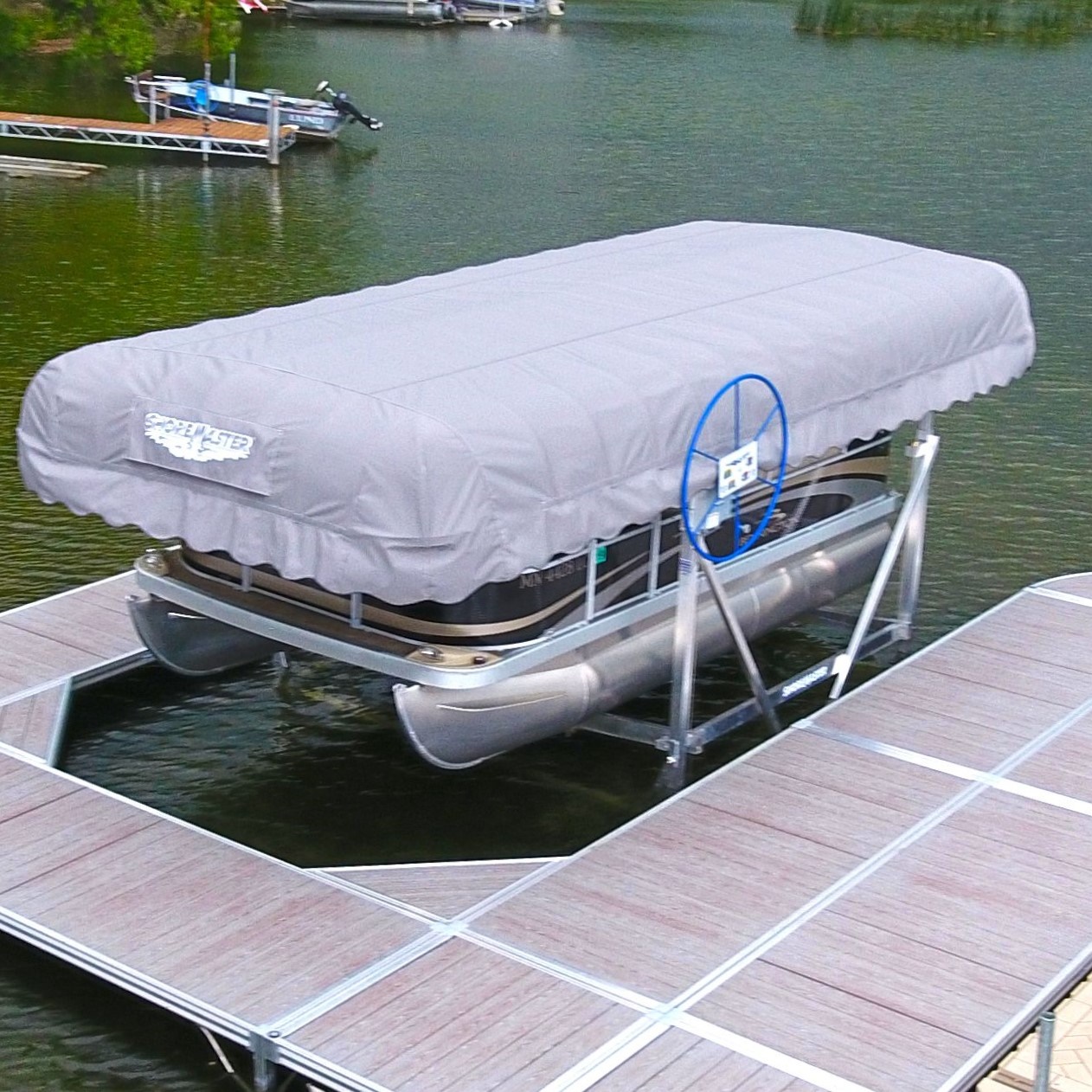
Pontoon Boat Lift
That means don’t head out onto the water when you know a storm is on the way. A pontoon boat is an investment you don’t want to risk for a few more minutes of fun. If inclement weather strikes, head back to the dock and put your boat back on your lift.
Where is Pier & Waterfront Solutions?
Located at 7325 St. Hwy 57, it’s 3 miles south of Sturgeon Bay and 1 mile past the intersection of Cty MM (heading north). Look on the right side, one mile north, at the next corner (Idlewild Road and Hwy 57).
For your protection PWS implemented these preventive measures:
1. Conducting as much business as possible by email, text, or phone.
2. Site visits will continue. When in-person contacts are necessary, we will follow “social distancing” guidelines.
3. Our display yard is always open for you to examine at your leisure. All displays have a numbered, red tag on them. If you want more information or pricing, please reference that number.
Thank you for allowing us to work with you.
YES – PWS is OPEN and waiting for you!
Please call, message, or email PWS with any questions.
Let’s all stay safe!
Aug 31, 2021
DOCK SWAY BRACE
Is a sway brace used on your dock? If not, does your dock sway as you walk on it? There are several reasons this can happen to any dock or pier.
There are main TWO reasons for dock movement.
You need to distinguish between the two types of movement. Is it an up and down movement, or is it a side to side movement?
First, Let’s tackle the Up and Down movement.
When installed, PWS makes sure the legs are firmly on the bottom. This typically makes the dock stable for most people.
Yet, over time, storms can wash out or move the sand or rocks under the footpads. Sand is more susceptible to this action.
It’s the same effect that erosion has on the shoreline. First, it washes away sand and small stones from under the footpad. Then, it continues to work on the remaining stones and rocks. When enough materials are removed, there is nothing left to support the leg.
At this point, you may experience the sensation of up and down movement as you walk.
How do we prevent it from happening?
There is no way to completely prevent washing out of the footpads. If we disturb the lake bottom too much, it weakens the tightly packed base. Disturbing the lake bottom makes it easier for the wave action to wash the sand away. The sand (or small stones) are loosely packed and have small openings in them.
The only “cure” is to reset the legs firmly on the bottom. We notice this frequently occurs after strong storms. The “white caps” you see are moving the water under the surface also.
The second type of movement is actual “sway.”
“Sway” is the side-to-side movement when the dock is set higher above the water.
The current water level is still above average even though it is down from 2019 and 2020. This is evidenced by the continued erosion happening up and down the shoreline.
PWS raises your dock up to protect it from high wave action during the summer. When the frames are adjusted higher, the pier becomes less stable. Walking on the dock will cause a side-to-side movement because the center of gravity is higher.
Think of a simple fishing pole. When the pole moves at the bottom, the movement is amplified at the top of the pole. The higher the frames are raised, the more side movement will occur.
See this link for more information.
There is a solution.
A sway brace on the legs reduces the sway side sway. You’ll feel more secure as you walk the length of your dock.
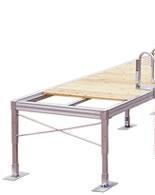
Sway Brace
Does every set of legs need sway braces?
No. PWS will make recommendations based on the heights and lengths of your dock or pier. Often, we add a single brace on a pair of legs. Next, we alternate the position in the opposite direction on the next set of legs.
One brace is attached near the bottom of one leg and clamped higher up on the opposite leg. This depends on the height of the legs.
It may involve a crew member having to submerge in the water to reach the bottom of the leg. In spring, that is not something anyone wants to do.
Does it matter if I have an aluminum or steel frame?
A steel frame is less likely to need braces than an aluminum frame due to its own weight. Different configurations are available for aluminum frames, but the principle is the same.
Braces are available for new installations, as shown here. There is an add-on version (independent components) for existing frames. They can be added to existing dock legs if needed. Either version will help stabilize your dock in deeper water.
Will sway braces help your dock?
Call Jerry at 920-493-4404 for more details.
Where is Pier & Waterfront Solutions?
Located at 7325 St. Hwy 57, it’s 3 miles south of Sturgeon Bay and 1 mile past the intersection of Cty MM (heading north). Look on the right side, one mile north, at the next corner (Idlewild Road and Hwy 57).
Is PWS OPEN?
Pier & Waterfront Solutions remains “open.” We have implemented measures to help ensure the safety of our employees and visitors. PWS continues to work to maintain the trusted service that you have come to expect.
PWS implemented these preventive measures:
1. Conducting as much business as possible by email, text, or phone.
2. Site visits will continue. When in-person contacts are necessary, we will follow “social distancing” guidelines.
3. Our display yard is always open for you to examine at your leisure. All displays have a numbered, red tag on them. If you want more information or pricing, please reference that number.
What can YOU do to help us?
1. Please conduct as much business as possible via emails, messaging, and emails. This step protects everyone involved.
2. When you see our crews installing equipment, please practice “social distancing.” Remain at a safe distance.
Thank you for allowing us to work with you.
YES – PWS is OPEN and waiting for you!
Please call, message, or email PWS with any questions.
Let’s all stay safe!
Aug 10, 2021
WHAT CAUSES SHORELINE EROSION?
Lakeshores are areas of constant dynamic energy. Powerful waves, high water, and ice move soil particles away from shorelines. In more severe cases, small pebbles and eventually rocks begin to wash out. When the water reaches far enough up the shoreline, erosion of lawns and exposing tree roots start.
We’ll try to answer some of your questions today.
What are the leading causes of shoreline erosion?
On open water like Green Bay, the three leading causes of erosions are:
-
- Wave action;
- High water; and
- Ice movement.
The ice on frozen lakes or the Bay can expand towards the shore with a force of many tons per square foot. The ice will destroy most obstacles in its path. Masses of ice put in motion by winds can push trees or buildings over, as exhibited here.
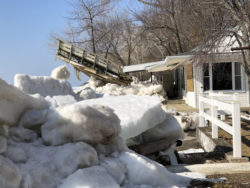
Ice vs deck erosion
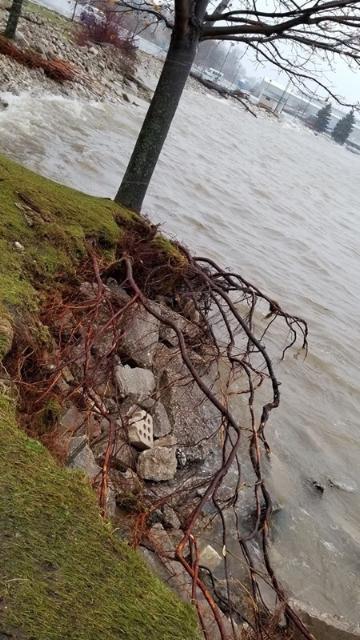
Shoreline tree roots exposed
Ice also pushes embankments, uprooting trees and lawns on small inland lakes. No matter how massive a tree is, the ice won’t slow down for it.
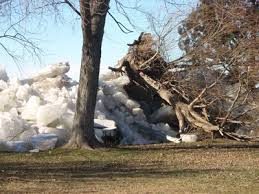
Ice Shove uprooting trees
In relatively small inland lakes, breaking waves can erode lawns away.
Headlands (points) usually have relatively high erosion rates. The waves, currents, and the ice will attack from all three sides. These attacks eventually transport the sediments to a new location where they settle in calmer weather.
Erosion is a normal process of nature.
Erosion and the redistribution of sediments is a natural process along shorelines. Typically, natural erosion proceeds very slowly. The plants and animals that live along the shore can adjust to these slow changes. They maintain a stable, healthy, productive ecosystem.
Accelerated erosion results when natural or human disturbances cause this equilibrium to be upset. Examples of this are higher than normal water levels and intense storms.
Human disturbances include vegetation removal, dredging, filling, or construction near the shoreline.
Another example of natural disturbances is large trees uprooted by a windstorm or a flood. When the soil becomes saturated with water, it weakens the soil around tree roots. The winds may uproot that tree.
IDENTIFY SERIOUS EROSION PROBLEMS
These are several signs of severe erosion problems. (Number one and three are significant)
- A large area of bare soil on a steep, high shoreline bank;
- A measurable change of the shoreline over time;
- Leaning or downed trees with exposed roots; and
- Large patches of muddy water near a lakeshore during periods of high water or following a rainstorm.
3 TYPES OF REACTIVE EROSION CONTROL METHODS:
Vegetative/No Mow: This method involves encouraging or planting trees or woody shrubs for the soil binding properties of their root systems. Grass and other plants will protect against raindrop impact and scouring from surface runoff.
Structural: This includes protective structures. The placement of rock of various sizes (rip-rap) has traditionally been the most effective and least expensive method.
Other structural methods include bulkheads, gabions (rock-filled baskets), and railroad ties. However, these methods are visually unappealing. They require more heavy equipment and technical expertise. These systems are more prone to failure than simple rip-rap. In addition, the DNR has disapproved of these methods in the past.
Manipulative: Mostly used on streams, this includes:
-
-
- Removing streamflow obstructions;
- Grading shoreline banks, or, in exceptional circumstances;
- Rerouting a stream channel.
Are there new techniques developed to prevent erosion?
A new soil preservation method called bioengineering has been proven successful.
Soil bioengineering combines mechanical, biological, and ecological concepts. These methods arrest and prevent shoreline erosion. An example is planting willows interspersed with rip-rap, where the rock provides immediate resistance to decay.
As the willows become established, roots invade and permeate the rock and underlying soil. They bind them together into an erosion-resistant mass. The willows also impart a more “natural” look to the shoreline.
Water levels are down; I don’t have to worry – Right??
This year, people do see water levels about 18-24″ less than in 2020. High water levels are the most significant contributing factor to shoreline erosion.
Will it stay down next year or in the years after? No one knows. In Las Vegas, that’s called a crapshoot.
What other factors affect my shoreline?
The next factor is the intensity of the storms. The Door County Peninsula had numerous high wind storms this year with up to 70 MPH winds.
A popular Marina in Sturgeon Bay: Skipper Bud’s Harbor Marina, located at the foot of the Michigan St. bridge, was a victim of a recent storm.
The marina had two of its five floating docks torn loose during a strong storm. Two tub boats quickly moved in place to prevent them from swinging into the bridge.
Are there other contributing factors to shoreline erosion?
You can expect water levels to rise rapidly when winds blow from the NW – NE direction for prolonged periods. This is despite the lower water levels this year. The stronger the winds, the higher the water will go. Waters south of Sturgeon Bay are particularly affected by these winds. In those areas, there are no other large outlets for the water to escape.
DO YOU NEED AN ESTIMATE FOR RIP-RAP?
Contact Dave@ 920-493-4406 or email at Dave@wisconsinpws.com.
What comes next?
Next week (on Aug 10, 2021), we will cover:
-
-
-
-
- Planning an erosion control project;
- Does erosion hurt my property values?
- What to expect for the cost of rip-rap.
Where is Pier & Waterfront Solutions?
Located at 7325 St. Hwy 57, it’s 3 miles south of Sturgeon Bay and 1 mile past the intersection of Cty MM (heading north). Look on the right side, one mile north, at the next corner (Idlewild Road and Hwy 57).
Is PWS OPEN?
The “Delta” variant is currently surging across the country.
Pier & Waterfront Solutions remains “open.” We have implemented measures to help protect the safety of our employees and visitors. PWS continues to work to maintain the trusted service that you have come to expect.
PWS implemented these preventive measures:
- Conducting as much business as possible by email, text, or phone.
- Site visits will continue.
- When in-person contacts are necessary, we follow “social distancing” guidelines.
- Our display yard is always open for you to examine at your leisure.
- All displays have a numbered, red tag on them. For more information, please reference that number.
What can YOU do to help us?
1. Conduct as much business as possible via emails, messaging, and emails.
2. When you see our crews installing equipment, please practice “social distancing.”
Thank you for allowing us to work with you.
YES – PWS is OPEN and waiting for you!
Please call, message, or email PWS with any questions.
Let’s all stay safe!
Aug 3, 2021
PIER & WATERFRONT SOLUTIONS
It’s been a fast-moving six months since our last article about PWS.
Dave Kalista and Jerry Englebert started in 2015. Like all new business owners, they were willing to put their futures on the line.
The first “office” consisted of a tiny room that was so small that you had to walk sideways to get to the table. It was the size of a closet in a new home.
All-Terrain Forklift
PWS tested an ATF that buried itself in the soft shoreline at Sugar Creek Park. It became clear that the machine would not work.
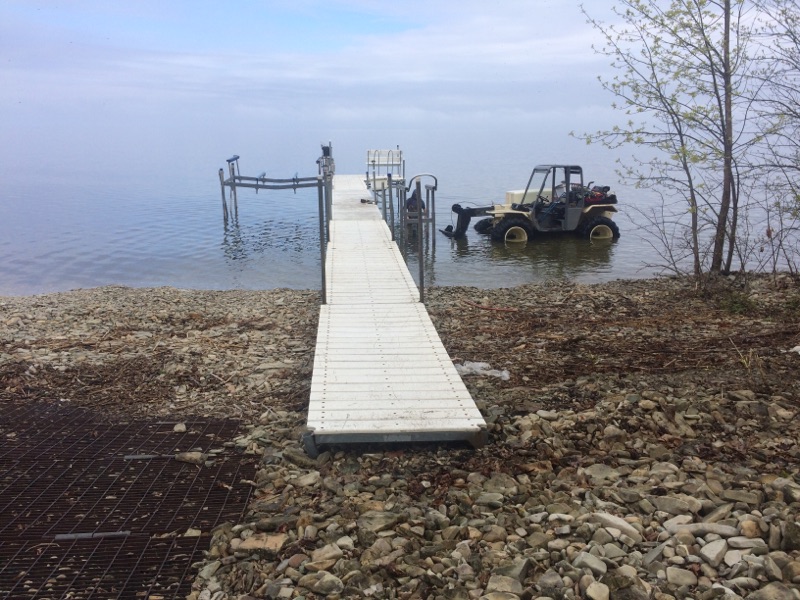
ATF for dock install
PWS bought the 1st All-Terrain Forklift and modified it to handle the conditions they would encounter.
While Jerry made sales, installs were done by hand or by using the All-Terrain Forklift. Dave operated the ATF along with Alex, our first employee. Alex is with us today and has his own crew.
PWS expanded
Pier & Waterfront Solutions moved out of the “closet” and into an office on Hwy 57 (our current location).
Today, manufacturing, a welding operation, and an assembly area occupy the warehouse. We still have room for a limited amount of equipment storage.
2016-2021 saw more ATF’s, crews, and trailers added – five ATF’s to be exact.
Meanwhile, the one-room office has grown into three offices. These offices accommodate the office staff of six required to handle the growing business.
PWS EXPANDED AGAIN
During late 2018 the Great Lakes and Green Bay experienced record water depths. The resulting damages included the loss of many shorelines. Trees and up to 50 feet of lawn washed away at some locations.
PWS responded by expanding its rip-rap business. PWS remains the only dock and boat lift company on the Door County peninsula to do so.

Enlarged 36′ x 45″ Barge
As the rip-rap business grew, we introduced a 24′ x 45′ barge and pusher boat. PWS needed the barge to protect the customer’s landscaping from damage.
In 2021, PWS added another section to the barge, making it a 36″ x 45′ barge. It continues to service both sides of the peninsula from Milwaukee to the tip of Door County.
Why such a large barge?
The barge allows PWS to transport excavators, track-mounted skid steers, and tons of boulders to the work sites from the waterside.
There is no damage to the landscaping.
It’s more economical for the homeowner, in most cases, and gives us access to areas that aren’t accessible by land.
GALVANIZED DOCK – NEXT INTRODUCTION
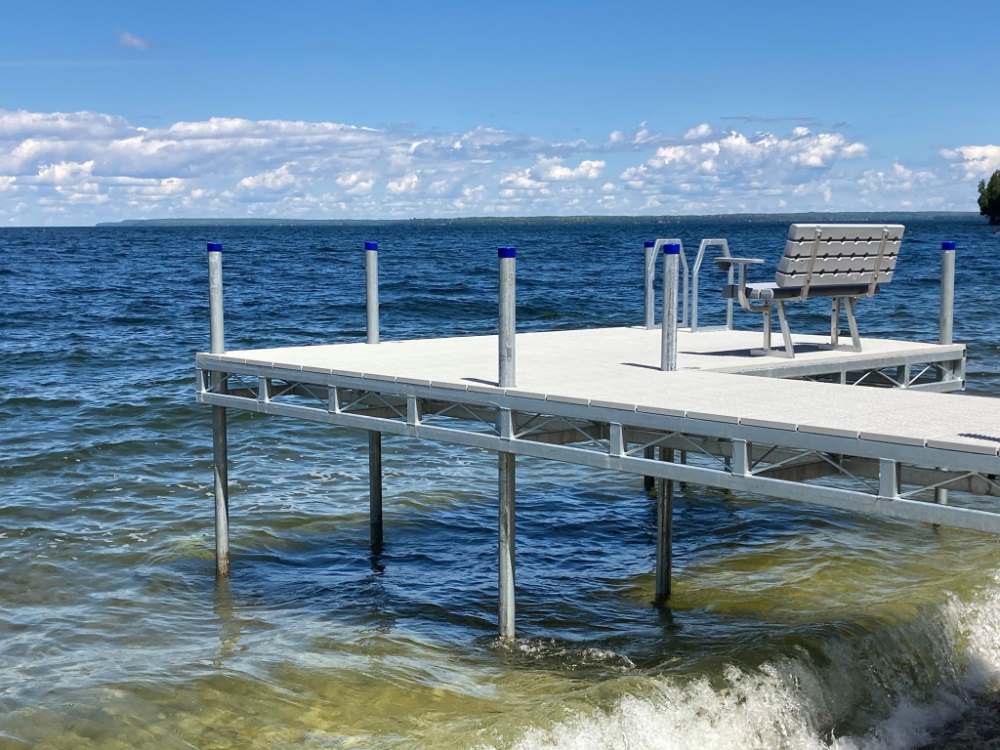
3-Season Pier
PWS developed a line of galvanized steel docks. The new docks use the best materials available today. Most steel docks are too light to handle the storms in open areas. Other models lacked the open-deck design of the 3-Season Pier.
After two years of testing, PWS introduced the 3-Season Pier. As a heavier, more robust steel pier, it is unmatched on Lake Michigan.
One of the features of the 3-Season Pier is a 25% larger platform. That’s more room for entertaining. Plus, it’s not a “special order.” “Special Order” is just another way of saying – more expensive.
The 3-Season Pier is available in 4′, 5′, and the prestigious 6′ width. The 3-Season Pier handles the high water and the strong storms you experience today.
The strength and dependability are evident when you look for a dock that will be around for a long time.
What was next?
The rapidly expanding business required more innovation to keep up with demand. In 2021, PWS added another barge. This time, equipped with a movable crane.
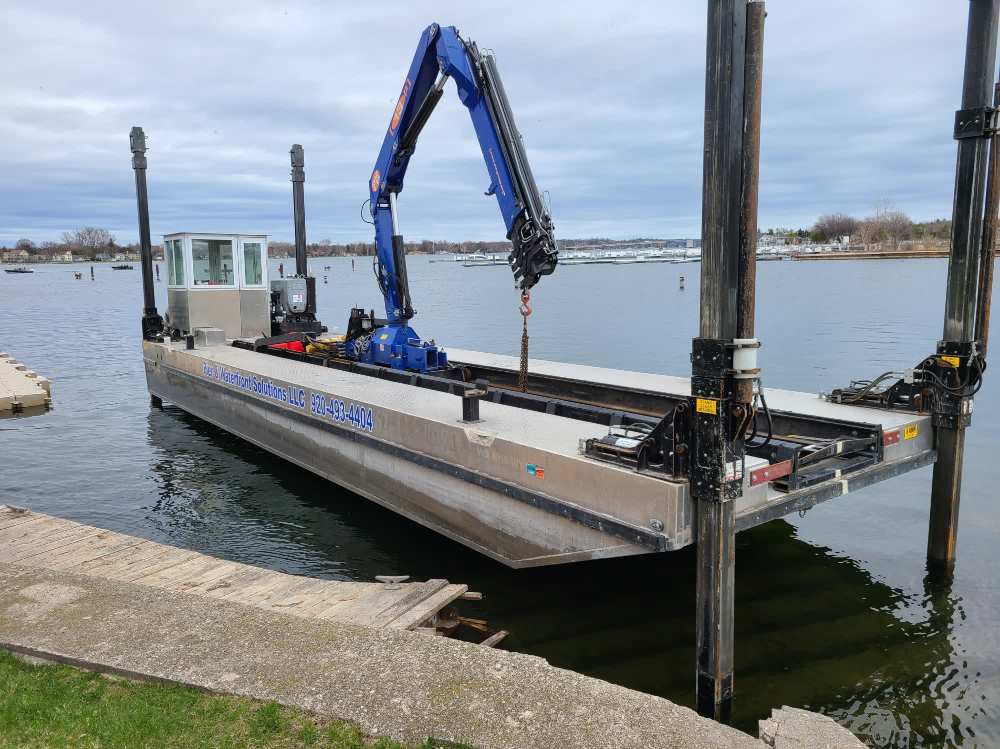
Barge w/ crane for dock removal
The “Small” barge (12′ x 45′) contains an articulating crane with a 60′ reach. The “small barge” eliminates the need for shore access by heavy equipment. The new crane also means reduced damage to a homeowner’s landscaping.
As Door County continues to build, land access for our equipment is diminishing. In the past, empty lots served as access to the shorelines. Today those lots are fully developed with manicured lawns and huge homes. In some areas, water access is the only available route.
What has happened to the Dock market in Door County?
The unexpected closure of an old dock business in Door County resulted in an influx of new customers. PWS is already planning its next moves to handle a large number of new customers. We plan to have everything ready for Spring 2022.
How will you find out about these changes?
The best way is to come back here each week and follow these posts on our website.
Summary
PWS already had the strongest aluminum dock as part of the ShoreMaster line. Now PWS has the strongest galvanized steel dock.
Call Jerry today. (920-493-4404) or email him at jerry@wisconsinpws.com or use this request form.
Tell Your Friends & Family
Visit Pier & Waterfront Solutions on Facebook.
Where is Pier & Waterfront Solutions?
Located at 7325 St. Hwy 57, it’s 3 miles south of Sturgeon Bay and 1 mile past the intersection of County MM (heading north). Look on the right side, one mile north, at the next corner (Idlewild Road and Hwy 57).
Is PWS OPEN?
Pier & Waterfront Solutions never closed. We have implemented measures to ensure the safety of our employees and visitors. We are working to maintain the trusted service that you have come to expect.
PWS implemented precautionary measures:
1. Conducting as much business as possible by email, text, or phone.
2. Site visits continue. When in-person contacts are necessary, we will follow “social distancing” guidelines.
3. Our display yard is always open for you to examine at your leisure. All displays have a numbered, red tag on them. If you want more information or pricing, please reference that number.
What can YOU do to help us?
1. Please conduct as much business as possible via emails, messaging, and emails. This step protects everyone involved.
2. When you see our crews installing equipment, please practice “social distancing.”
Thank you for allowing us to work with you.
YES – PWS is OPEN and waiting for you!
Please call, message, or email PWS with any questions.
Let’s all stay safe!
Apr 6, 2021
The best dock selection in Door County
Pier & Waterfront Solutions customers have access to the best dock selection, more dock styles and more materials than any other Door County dealer.
Most dealers offer only aluminum docks or a few lightweight steel dock. Some even offer one or two brands.
Aluminum is popular because it is lightweight and easier to handle.
Who has the best aluminum dock in Door County?
Pier & waterfront Solutions offers (6) ShoreMaster aluminum constructions – in roll-in, stationary, and floating docks.
Now that’s a some dock selection!
Here is a comparison of the aluminum constructions offered:
RS 4 –
4″ side rails. 10′ sections, seven types of decking, aluminum or steel legs. Ideal for calm waters on an inland lake or sheltered area.
RS 4 Curved –
The RS4 Curved dock sections are built the same as the same rigorous specs as the RS 4 shown above. Why is this different? The availability of 45- degree and 90-degree curved sections. These curved sections allow for many configurations that no one else offers. (Hint – You can use curved sections with the ANY ShoreMaster dock frame to genuinely make your dock unique.
RS7*
7″ side rails. 8′ and 16′ sections, with seven types of decking, aluminum or steel legs. Ideal for the rough waters in an open area.
TS9*
9″ Truss side frames. 8′ and 16′ sections, seven types of decking, aluminum or steel legs. Ideal for the rough waters in most open areas.
FTS9 –
The FTS9 has the identical construction of the TS9 in all respects. The frames have floats attached and are ideal for soft muddy bottoms.
Poly Dock –
Poly Dock is a modular dock design made of rotationally molded polyethylene. There are NO unsightly black floats used.
It’s a floating dock system that can withstand up to 2′ waves, making it ideal for inland lakes or rivers with muddy bottoms and large water fluctuations.
Over the years, PWS provided hundreds of ShoreMaster aluminum docks, but it is not always the best solution for all shorelines.
What other dock selection is available?
With the high water and intense storms we have experienced in recent years, PWS now offers the exclusive
3-Season Pier

3-Season Pier
The 3-Season steel pier is built to demanding specifications for strength and durability.
3-Season piers have withstood just about everything Mother Nature can throw at it. No Wisconsin manufacturer builds a heavier frame section. It weighs over a quarter ton without the oversized steel legs.
PWS recommends flow-through decking for the 3-Season pier. Flow-through decking relieves any upward pressure caused by a storm’s high waves.
PWS installs everything we sell.
Now you know why Pier & Waterfront Solutions is so popular.
We offer everything you need for your dock or lift. Contact us TODAY!
Where can I find Pier & Waterfront Solutions?
Pier & Waterfront Solutions, 7325 St. Hwy 57, is located 3 miles south of Sturgeon Bay. Go 1 mile PAST the intersection with County MM (heading north). Look on the right at the next corner – Idlewild Road and Hwy 57.
Pier & Waterfront Solutions remains “open” year-round.
The Covid-19 virus continues to spread and affects many people. We are conducting as much business as possible by email, text, or phone.
Site visits continue as usual. When making in-person contacts, we follow “social distancing” guidelines when possible.
PWS display yard – OPEN 24-7
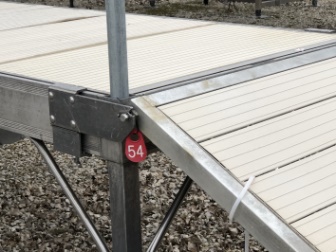
Red Tag
PWS‘s display area is always open for you to examine at your leisure. All displays available for sale have a numbered, red tag on them. Want more information on something you saw in our yard? Please reference that number when you inquire.
PWS provides estimates by email to make the process faster, safer, and paperless.
Call, message, or email Jerry with any questions.

Jerry Englebert
Contact Jerry at 920-493-4404 for more information or use this link.
* Combine the RS4 Curved sections with this frame for a unique design.

















